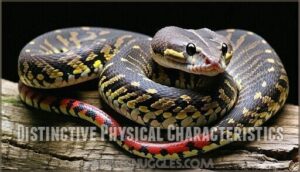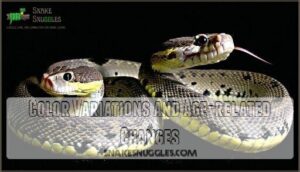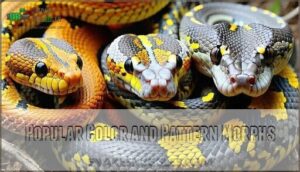This site is supported by our readers. We may earn a commission, at no cost to you, if you purchase through links.

The true red-tailed boa (Boa constrictor) stands as the classic giant, reaching impressive lengths with distinctive reddish tail patterns. Central American boas (Boa imperator) offer a more manageable size and docile temperament, making them popular pets.
The recently recognized Boa sigma completes this trio, though it’s less commonly seen. Each species contains multiple subspecies, like the stunning Peruvian long-tail or the compact Argentine boa, each adapted to their specific environments.
Think of them as nature’s own neighborhood specialists, each perfectly suited to their corner of the Americas, with unique traits that make identification both challenging and rewarding.
Table Of Contents
- Key Takeaways
- Boa Constrictor Species and Subspecies
- True Red-Tailed Boa (Boa Constrictor Constrictor)
- Central American Boa (Boa Imperator)
- Unique Boa Constrictor Subspecies
- Boa Constrictors in The Pet Trade
- Frequently Asked Questions (FAQs)
- How many types of Boa constrictor are there?
- What is a boa constrictor?
- Are boa constrictors good snakes?
- Are boa constrictors invasive?
- What do Boa Sigma & constrictor have in common?
- Do you have boa constrictors at home?
- What is the Difference Between a Boa Constrictor and a Northern Boa (Imperator)?
- Are Boa Constrictors Venomous?
- Are There Any Endangered Boa Constrictor Subspecies?
- Is There a Difference Between the Clouded Boa and the Dominican Clouded Boa?
- Conclusion
Key Takeaways
- You’ll find three main boa constrictor species: the true red-tailed boa (Boa constrictor) that’s the largest and most iconic, the manageable Central American boa (Boa imperator) that’s perfect for beginners, and the recently recognized Boa sigma from Mexico’s islands.
- You can identify true red-tailed boas by their distinctive tan bodies with saddle-like markings that transform into brilliant red coloration toward the tail, and they’re the largest subspecies, reaching up to 12 feet in exceptional cases.
- You’ll discover that Central American boas are ideal pets due to their docile temperament, smaller 5-7 foot size, and wide variety of color morphs like Sunglow and Anery, making them beginner-friendly compared to their larger cousins.
- You should know that several subspecies face conservation challenges, particularly the Argentine boa which is listed on CITES Appendix I due to habitat destruction, while captive breeding programs work to preserve genetic diversity and support wild population recovery.
Boa Constrictor Species and Subspecies
You’ll encounter three primary species within the boa constrictor complex: Boa constrictor, Boa imperator, and the recently recognized Boa sigma, each containing multiple subspecies with distinct geographic ranges, physical characteristics, and behavioral traits.
Understanding these taxonomic divisions becomes essential when you’re identifying specific populations, as overlapping ranges have created hybrid zones that complicate classification.
Particularly in captive breeding programs where locality information often gets lost across generations.
Boa Constrictor
When discussing boa constrictor types, you’re looking at the crown jewel of the genus.
When selecting your first boa constrictor, you’re choosing a serpentine masterpiece that will captivate you for decades.
This species showcases remarkable genetic diversity across its range, with constriction mechanics perfected through millions of years of boa evolution.
Here’s what sets B. constrictor apart:
- Eight recognized subspecies with distinct morphology
- Advanced sensory perception for hunting
- Largest body size among boa species, which is a key factor in its genetic diversity
Boa Imperator
When you’re exploring boa constrictor types, the Central American boa (Boa imperator) stands out with distinct temperament differences from its South American cousin.
This subspecies shows remarkable regional variations across Mexico through Central America, making captive breeding programs essential due to conservation concerns.
However, hybridization risks complicate pure bloodline maintenance in the pet trade today, which is a concern for conservation concerns.
Boa Sigma
You’ll discover Boa sigma represents a fascinating example of island endemism, recently elevated to full species status through advanced taxonomy research.
This Mexican subspecies showcases unique sigma morphology that sets it apart from other Boa constrictor relatives.
Its genetic uniqueness demands immediate conservation needs, making captive breeding programs essential for preserving this remarkable snake subspecies for future generations.
Recognized Subspecies of Boa Constrictor
Eight distinct subspecies of Boa constrictor showcase remarkable Geographic Variations across their native ranges, each displaying unique characteristics that aid in Subspecies Identification.
This Genetic Diversity among boa constrictors reflects millions of years of evolutionary adaptation, though modern Hybridization Concerns and habitat loss threaten their distinct lineages, prompting increased Conservation Efforts.
- B. c. constrictor – True red-tailed boa from South America
- B. c. imperator – Northern boa spanning Mexico to Colombia
- B. c. occidentalis – Massive Argentine boa from Andean regions
- B. c. longicauda – Peruvian long-tail with extended proportions
Hybrid Localities in Captivity
When you encounter boas in captivity, hybrid identification becomes challenging because purposeful interbreeding creates snakes with blended characteristics.
These snake hybrids showcase unique morph expression patterns that don’t match pure subspecies, affecting genetic diversity.
While interbreeding produces visually striking variations, breeding ethics questions arise regarding conservation impact.
Snake genetics become muddled, making it nearly impossible to determine your boa’s true lineage.
True Red-Tailed Boa (Boa Constrictor Constrictor)
You’ll recognize the True Red-Tailed Boa (Boa constrictor constrictor) as the most iconic subspecies, featuring the classic tan body with distinctive saddle-like markings that transform into brilliant reddish coloration toward the tail.
This South American native can reach impressive lengths of up to nine feet, making it both the largest and most widely recognized member of the boa constrictor family.
Distinctive Physical Characteristics
A true standout among boa constrictor characteristics, the red-tailed boa boasts iconic features.
Its bat-shaped saddle patches create a striking contrast against a tan body, while the vibrant red tail grabs attention instantly.
Dark spots nestled between saddle markings add intricate texture.
These unique scale patterns emphasize their elegance and leave no doubt why they’re favorites among snake enthusiasts exploring boa constrictor morphs and natural beauty.
Size Range and Average Length
Red-tailed boas showcase remarkable sexual dimorphism, with females often growing larger than males.
These boas usually measure 7-10 feet, though exceptional individuals can reach 12 feet.
Captive growth varies due to diet and habitat. Understanding their impressive size range enhances care for these beautiful snakes.
| Feature | Average Size | Rare Maximum |
|---|---|---|
| Males | 6–8 feet | 10 feet |
| Females | 8–10 feet | 12 feet |
| Captive Growth Impact | Size increases | Significant |
Color Variations and Age-related Changes
As red-tailed boas mature, their snake coloration undergoes vivid ontogenetic changes.
These magnificent serpents transform from dull juveniles into vibrant, pattern-rich adults through remarkable color evolution.
Those dull, grayish baby hues often evolve into rich, reddish-brown tones accented by bold, saddle-like snake patterns.
Iridescent scales enhance their visual appeal while regional differences can add unique traits.
Rare morphs, like melanism or albinism, highlight fascinating variations.
Over time, pattern fading may also occur, creating stunning contrasts.
Natural Habitat and Distribution
The boa constrictor’s habitat diversity is remarkable, stretching across South America’s vast landscapes.
You’ll find them in lush Amazon rainforests, dry tropical woodlands, grassy savannas, and humid coastal areas.
Adapted to various climates, they thrive where prey and cover exist.
Their geographic ranges often overlap, showcasing their ability to adapt to multiple terrains, from dense forests to open savannas.
Behavior and Temperament
While Red-Tailed Boas are solitary hunters, their snake behavior showcases clever hunting strategies like ambush and constriction.
Snake temperament varies; they’re gentle in captivity yet alert.
Social interactions are rare, except during breeding.
Their activity patterns shift with age—juveniles climb more, adults stay grounded.
With proper snake handling, these boa constrictors demonstrate patience and adaptability, making them fascinating companions.
Central American Boa (Boa Imperator)
You’ll find the Central American Boa, or Boa Imperator, to be one of the most adaptable and widely distributed boa species.
Known for their manageable size and calm temperament, they’re a favorite among hobbyists and researchers alike, making them a notable species due to their calm temperament.
Physical Characteristics and Size
The Central American Boa, or Boa imperator, has a sleek frame marked by unique scale patterns and balanced body proportions.
Males are usually smaller than females, highlighting their sexual dimorphism.
On average, these boas reach 5 to 7 feet, with notable tail length reflecting their majestic snake size.
Their growth rate varies, but coloration often deepens with age.
- Key Physical Highlights
- Length: Typically 5–7 feet.
- Males vs. Females: Sexually Dimorphic; females grow larger.
- Tail/Proportion: Feature balanced tails aiding movement.
- Growth labeled age illustrates genetic interactions
Docile Nature and Suitability as Pets
If you’re researching pet snakes, Boa imperator stands out for its beginner friendliness and snake docility.
These boas are known for calm temperament variations and captive breeding practices that enhance manageable behavior.
Proper handling techniques guarantee comfort for both you and the snake, while ethical considerations, like supporting responsible breeders, make caring for these pet snakes a rewarding and enjoyable experience.
Popular Color and Pattern Morphs
Central American Boa morphs fascinate enthusiasts with their vibrant colors, unique patterns, and intriguing genetics.
Designer morphs like Sunglow and Snowglow enhance pattern aberrations and color intensity, while Anery boas showcase silver tones.
Captive-bred morphs reveal endless possibilities for future morphs, blending striking pattern variation with selective breeding.
Each snake pattern highlights the artistry of their genetics, making them showstoppers in the reptile world.
Natural Habitat and Geographic Range
Boa imperators showcase incredible habitat diversity, thriving across Central America in rainforests, arid lands, and savannas.
With regional adaptations, they adjust to climates from humid jungles to dry forests.
Endemic subspecies like the Mexican boa prefer biome specificity, highlighting their unique snake distribution.
Despite their invasive potential, these boa constrictors are essential to balancing ecosystems throughout their natural range, spanning Central and South America.
Care Requirements in Captivity
Caring for a Central American boa starts with a proper habitat. Provide:
- Enclosure size: Minimum 6x2x2 feet.
- Temperature gradient: Set basking spots at 90°F, cooler areas around 75°F.
- Humidity levels: Keep between 60-80% for healthy shedding.
- Substrate choices: Coconut husk or cypress mulch supports burrowing.
Balanced diets, enrichment needs, and gentle handling complete boa constrictor care.
Unique Boa Constrictor Subspecies
Boa constrictors are a diverse species, with certain subspecies standing out due to their unique traits and adaptations.
From striking patterns to specialized habitats, these snakes showcase the remarkable variety within this fascinating group.
Peruvian Long Tail Boa (B. C. Longicauda)
The Peruvian longtail boa, a stunning Boa constrictor subspecies, stands out with its distinctive markings—dark black and gold patterns contrasting vividly under the light.
Found in the Tumbes region of Peru, its habitat specifics include dry forests and semi-arid regions.
Despite their beauty, conservation challenges persist due to a small natural range.
Here’s a quick overview:
| Feature | Details |
|---|---|
| Scientific Name | Boa constrictor longicauda |
| Size Range | 6-7 feet |
| Notable Pattern | Black spearhead on head |
| Conservation Status | Limited data, range-specific |
The Peruvian longtail boa has a size range of 6-7 feet, and its notable pattern includes a black spearhead on the head, making it a unique and visually striking species.
Argentine Boa (B. C. Occidentalis)
Stretching up to 10 feet in length, the Argentine Boa stands out for its impressive boa constrictor size and beautiful iridescent scales.
Known for its dark coloration with lighter patterns, this boa constrictor thrives in Argentina’s forests and semi-arid regions.
Unfortunately, habitat threats jeopardize its survival, pushing conservation efforts to protect its temperament and unique allure in today’s shrinking boa constrictor habitat.
Other Notable Subspecies and Their Characteristics
The domain of Boa constrictor subspecies offers remarkable diversity.
From dwarf boas like B. c. amarali with vibrant patterns to island boas like B. c. nebulosa, known for cloud-like markings.
B. c. orophias, with its slender build and unique head, thrives in Saint Lucia.
Each subspecies varies in temperament, color morphs, scale counts, and habitats, showcasing fascinating natural adaptations.
Conservation Status of Rare Subspecies
Several rare boa subspecies face extinction threats that demand immediate attention.
The Argentine boa (B. c. occidentalis) tops CITES Appendix I due to severe habitat destruction, while the Pearl Island boa struggles with limited populations.
You’ll find these conservation challenges particularly concerning:
- Habitat Loss – Deforestation eliminates critical ecosystems
- Illegal Trade – Black market demand threatens wild populations
- Climate Change – Shifting temperatures disrupt breeding cycles
Breeding Programs for Endangered Populations
Breeding programs serve as genetic lifelines for endangered species like the Argentine Boa.
Captive management requires careful genetic testing to maintain diversity while avoiding inbreeding.
Conservation efforts combine habitat preservation with reintroduction strategies, ensuring populations remain viable.
Ethical considerations guide these programs, balancing snake breeding success with wild population recovery for long-term survival, and overall conservation efforts.
Boa Constrictors in The Pet Trade
When you’re considering a boa constrictor as a pet, you’ll find that Central American boas (Boa imperator) dominate the reptile trade due to their docile temperament, manageable size of 6-8 feet, and extensive range of color morphs including pastels, albinos, and hypos.
You should understand that these captive-bred specimens require specific housing conditions with temperature gradients of 78-88°F, appropriate humidity levels of 60-70%, and a feeding schedule of appropriately-sized rodents every 2-3 weeks, making them suitable for dedicated keepers with proper knowledge of their care requirements.
Common Species and Morphs Available
Three main species dominate today’s market, each offering distinct advantages for collectors.
Boa imperator leads in beginner boas due to manageable size differences, while true redtail boa specimens showcase premium color mutations. Availability trends favor captive-bred animals over wild-caught imports.
Here’s what drives current morph popularity among boa constrictors:
- Albino morphs – These golden beauties lack dark pigments, creating stunning yellows and oranges
- Hypo varieties – Reduced melanin produces lighter, more vibrant base colors
- Sunglow combinations – Mixing albino and hypo traits creates ethereal, glowing appearances
- Jungle patterns – Aberrant markings replace typical saddles with chaotic, artistic designs
- Pastel mutations – Soft, muted tones appeal to collectors seeking subtle elegance
Selecting a Healthy Boa Constrictor
Before purchasing any boa constrictors, examine your potential snake species carefully.
Look for clear eyes without cloudiness, smooth scales with no retained shed, steady breathing without wheezing, and proper body weight that’s neither too thin nor overweight.
Temperament signs matter too—healthy Boa constrictor subspecies display calm, alert behavior rather than aggressive strikes or lethargy.
| Health Indicator | Good Signs | Warning Signs |
|---|---|---|
| Clear Eyes | Bright, alert appearance | Cloudy, sunken, or discharge |
| Scale Condition | Smooth, intact scales | Retained shed, mites, wounds |
| Respiratory Health | Quiet, steady breathing | Wheezing, mouth breathing, mucus |
| Body Weight | Well-rounded, firm muscle tone | Visible ribs, obesity, weakness |
Housing and Care Requirements
Setting up proper housing transforms your boa constrictor’s quality of life dramatically.
These powerful constrictors need adequate space, controlled climate conditions, and thoughtful environmental design to thrive in captivity.
To guarantee proper living conditions, consider adequate product availability.
Essential pet care requirements include:
- Enclosure Size – Minimum 6x2x2 feet for adults
- Temperature Gradient – 88-92°F basking, 78-80°F cool side
- Humidity Levels – Maintain 50-60% consistently
- Substrate Choice – Cypress mulch or paper towels
- Enrichment Needs – Hiding spots, climbing branches, water bowl
Feeding Habits and Diet in Captivity
Getting your housing sorted is just the start—your boa’s appetite demands equal attention.
Proper boa constrictor diet management prevents obesity while ensuring nutritional needs are met.
Prey size should match your snake’s thickest body section, with feeding schedules varying by age and species.
| Age Group | Feeding Frequency | Prey Size |
|---|---|---|
| Juveniles | Every 5-7 days | Mouse hoppers to adult mice |
| Adults | Every 2-4 weeks | Adult rats to small rabbits |
| Seniors | Every 4-6 weeks | Medium rats, adjusted portions |
Frozen prey offers safety advantages over live feeding, eliminating injury risks while maintaining nutritional value.
You can find various options for boa constrictor prey online.
Most boa constrictors in captivity thrive on pre-killed rodents, though some individuals may require live prey initially.
Supplementation needs remain minimal with whole prey diets, as rodents provide complete nutrition for healthy snakes.
This approach ensures a balanced diet and supports the overall health of your boa.
With the right feeding schedule, your boa constrictor will lead a healthy life.
Handling and Socialization Techniques
Safe Handling your boa constrictor requires patience and consistent Temperament Training to build trust.
Start with brief sessions, supporting their body weight while avoiding sudden movements that trigger snake defensiveness.
Regular handling provides Socialization Benefits, Reducing Stress and snake aggression over time.
Always approach calmly, read their body language, and respect their boundaries for effective Bite Prevention and lasting Boa constrictors companionship.
Frequently Asked Questions (FAQs)
How many types of Boa constrictor are there?
Variety is the spice of life," and you’ll find that taxonomists recognize three main boa species with multiple subspecies.
There’s Boa constrictor with eight subspecies, Boa imperator, and the recently identified Boa sigma from Mexico’s islands.
What is a boa constrictor?
A boa constrictor is a large, non-venomous snake that kills prey by wrapping around and squeezing it.
You’ll find these powerful constrictors throughout Central and South America, hunting birds and mammals.
Are boa constrictors good snakes?
You’ll find these constrictors make excellent pets when you’re prepared for their needs. They’re generally docile, rarely bite, and adapt well to captivity with proper care, housing, and handling experience.
Are boa constrictors invasive?
Are you wondering if these powerful constrictors pose ecological threats?
Boa constrictors can become invasive when introduced outside their native South and Central American ranges, disrupting local ecosystems by preying on native wildlife species, which can lead to significant ecological damage, as they are powerful constrictors.
What do Boa Sigma & constrictor have in common?
You’ll notice both Boa sigma and Boa constrictor share the same genus, possess non-venomous constriction abilities.
They give birth to live young, and maintain similar semi-arboreal hunting behaviors across their overlapping Central American ranges, with non-venomous constriction abilities and semi-arboreal habits being key characteristics.
Do you have boa constrictors at home?
I’m not a snake keeper myself, but you’re asking about owning these magnificent constrictors.
They require specialized care, proper permits, and significant commitment.
Consider your experience level, local laws, and long-term housing needs first.
What is the Difference Between a Boa Constrictor and a Northern Boa (Imperator)?
You’re looking at two names for virtually the same snake.
"Boa constrictor" refers to the entire species, while "Northern Boa" or "Boa imperator" specifically identifies the subspecies found in Central America and northern South America.
Are Boa Constrictors Venomous?
No, you don’t need to worry about venom with boa constrictors.
They’re completely non-venomous snakes that rely on constriction to subdue their prey, using their powerful muscles rather than toxic bites.
Are There Any Endangered Boa Constrictor Subspecies?
Don’t count your chickens before they hatch" applies perfectly here—several boa subspecies face extinction risks.
You’ll find the Argentine boa listed as threatened, while Saint Lucia’s boa carries endangered status with hefty protection fines.
Is There a Difference Between the Clouded Boa and the Dominican Clouded Boa?
The Dominican Clouded Boa is actually a specific subspecies of the broader "clouded boa" category.
You’re looking at Boa constrictor nebulosa, which is endemic to Dominica island and distinct from other clouded varieties.
Conclusion
Exploring the labyrinthine world of serpent taxonomy might seem as complex as untangling a shed snake skin, but understanding the different types of boa constrictors becomes straightforward once you’ve grasped the key distinctions.
Whether you’re drawn to the impressive proportions of true red-tailed boas, the manageable nature of Central American species, or the unique characteristics of specialized subspecies, each offers distinct advantages for both study and captivity.
Your journey into boa constrictor diversity starts with recognizing these fundamental differences, which is crucial for a deeper understanding of these fascinating creatures.


















